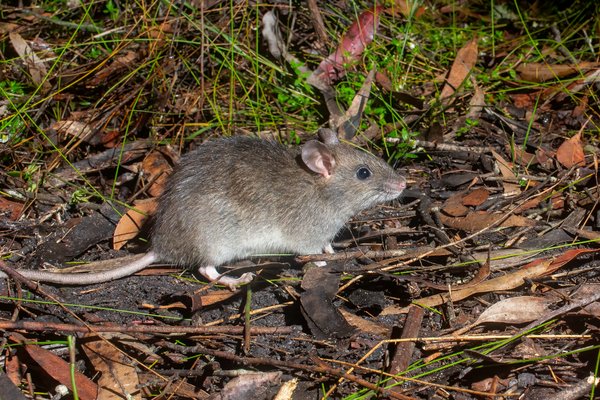Malaita’s monster rat
Our team is again drawn toward Malaita’s cloud forests and we find an exciting sign of the giant rat we’re looking for.

© Australian Museum
“Mala (Malaita Island) has a monster rat called rete. At Sa’a wild cats have practically destroyed them. They are described as being like a rat but on a much larger scale. The teeth are enormously strong and can crack Canarium nut or strip off the husk from a young coconut.”
These were the words of Walter Ivens who in 1927 wrote about the existence of a species of mammal that to this day has remained undocumented by scientists. Among the Kwaio, Malaita’s rat is known as kwete. Many of their songs and kastom stories are interwoven with knowledge of this animal and the strong incisors of its lower jaw were once used to carve intricate designs in pendants and ornaments.
In the 90 years since Ivens published his text, few scientists have attempted to find this species. One of the few was Professor Tim Flannery. In the early 1990’s Tim ventured into one of the most isolated reaches of Malaita’s mountains. He combed areas of primary forest and interviewed local hunters, searching for evidence of kwete. Years later, he published a collection of stories and experiences from this and other work among the islands. Within his book, Tim described how he had developed the same fears as Ivens - that the giant rat was now extinct, most likely as a result of predation by feral cats.
In 2014, David MacLaren read the passage about kwete in Tim’s book. In a similarly isolated corner of the East Kwaio mountains he asked his colleague Esau Kekeubata if he had ever heard about kwete when he was a small boy. Esau quickly responded “What do you mean heard about one when I was a small boy? I saw one with my own eyes a few years ago!”.
This glimmer of hope provided by Esau was enough to spur us toward Malaita. Our team was not naïve to the difficulty of our task. The monster rat might indeed be extinct, if not it was no doubt extremely rare. Furthermore, Malaita is a big island and the primary forests there are dense and difficult to survey. Unperturbed, for the second time this year we hacked our way to the top of Mt Tolobusu, this time for a dedicated search of the cloud forests.
In addition to looking for kwete, we were intent on providing the answer as to whether a monkey-face bat was also hiding out on Malaita. We faced a considerable journey to return to the field site. Starting from Atoifi on the eastern coastline we walked up to Kwainaa’isi at 900m above sea level, back down into the central La’fea valley, and up again to Kwaio’s 1200m high peak, spreading the hike out over three days. With our camp established on the eastern slopes, we began to erect mist nets along the high ridgelines to capture bats.
After two nights we had only captured 14 bats, an absolutely dismal result! Our team notified me that this was likely because we had foolishly neglected to acknowledge the ancestors. It was something that should be rectified quickly in order to improve our chances. Alabi took a small donation of two Solomon dollars to a local shrine as a dedication and Esau paid for a pig that was similarly offered in request for assistance from the ancestors. In the meantime the rest of us feverishly positioned more nets along the ridgelines. The result – our captures went from 6 the previous night to a total of 91 that night! Unfortunately however, a monkey-face bat was not amongst the swarms of captured bats and I feel we are not yet closer to confirming if one exists on Malaita.
We pulled camp and descend back down the steep slopes to Kwaina village in the La’fea. Following a brief rest in the village, people from across the kwaio region began to emerge from the village’s nooks and crannies. Out of their woven baskets and rice bags they produced the camera traps we had dispersed on our first expedition to capture a photograph of kwete. Camera after camera showed us images of pigs, feral cats, Melanesian megapodes and introduced Pacific rats. One group had faced their camera toward the base of a ngali nut tree and cunningly placed nuts there to attract the kwete. We watched as black rats (Rattus rattus) repeatedly retrieved nuts from the pile.
Thankfully, the group had also collected the nuts chewed by the rats and it turned out to be a massive turning point. The marks left behind were completely different to those from the giant rats we saw Bougainville. If only we could find some similar on Malaita we may have some hope. Almost on cue John Batee emerged from the crowd and to my delight in his hand were chewed nuts that were the spitting image of those from Bougainville! It was the evidence we needed, and I am now almost certain that kwete still survives in La’fea’s vast forests. With a little more persistence and some luck I’m sure we can soon shed light on one of the longest-standing mysteries concerning Melanesia’s mammals.
Tyrone Lavery, Australian Museum Research Institute Expedition Fellow
Dr Tyrone Lavery from the University of Queensland is the inaugural recipient of the Australian Museum Research Institute's Expedition Fellowship for 2015/16. Tyrone is playing a large part in AMRI's presence in the Solomon Islands over the coming months, where ground-breaking research on native mammal populations will take place. Tyrone's area of specialty is exotic bats and rats, hence his important role in the Australian Museum's Solomon Island Expedition. Tyrone will be providing periodic updates on his involvement in this research expedition, which can be followed through our AMRI Blog feed.











